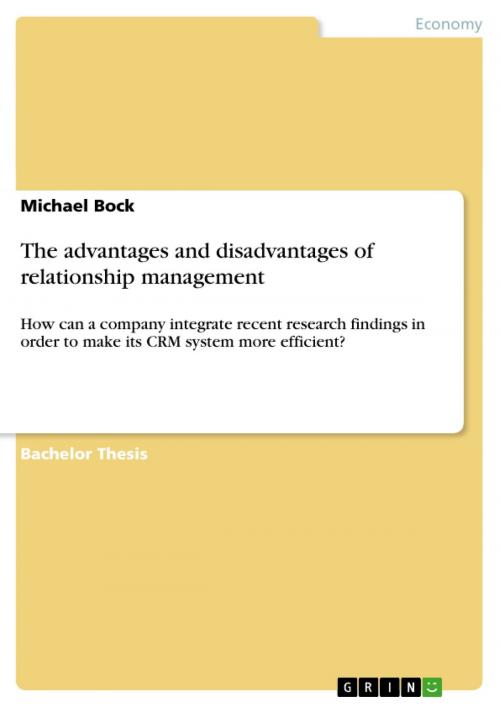The advantages and disadvantages of relationship management
How can a company integrate recent research findings in order to make its CRM system more efficient?
Business & Finance, Marketing & Sales| Author: | Michael Bock | ISBN: | 9783640712144 |
| Publisher: | GRIN Publishing | Publication: | September 29, 2010 |
| Imprint: | GRIN Publishing | Language: | English |
| Author: | Michael Bock |
| ISBN: | 9783640712144 |
| Publisher: | GRIN Publishing |
| Publication: | September 29, 2010 |
| Imprint: | GRIN Publishing |
| Language: | English |
Bachelor Thesis from the year 2008 in the subject Business economics - Marketing, Corporate Communication, CRM, Market Research, Social Media, grade: 1,2, Maastricht University (School of Business and Economics), course: -, language: English, abstract: 1. General introduction Up to now, it has always been the task of marketing to be close to the customer and to know how to reach him in order to ultimately increase sales of the company's product or service. This focus on customer acquisition is widespread among companies, and many companies consider this to be sufficient in order to survive in the business world. Nonetheless, a vital flaw of this common view is that there is more than just focusing all efforts on acquiring new customers - That is, convincing the customer that it pays for him/her to continue doing business with the provider, which is called customer retention. Enter Customer Relationship Management (CRM). Throughout this paper, the definition of a CRM will be equivalent to the interpretation by Payne and Frow (2005), who state that CRM is a strategic approach that is concerned with creating improved shareholder value through the development of appropriate relationships with key customers and customer segments (Payne and Frow, 2005a). In the 1990s, organizations recognized the need for not relying on customer acquisition all alone, and stressing the relationship with the customer became imperative in the business world's strategic orientation. Unfortunately, implementing CRM systems turned out to require more work than the plain desire to be chosen as a provider over and over again. A great source of uncertainty was the vague definition of relationship management itself. Another pitfall was how to establish a CRM system in an organization. As relationship management was not up to executives' expectations, many companies were disappointed by the results - And yet, there were companies that succeeded in implementing a CRM system. Taking a closer look at the markets all over the world shows that all leading companies within their industries possess CRM systems, no matter whether it is in a B2B or B2C setting. This paper aims to convey how a company can use latest research findings to enhance a CRM system in order to maximize benefits and minimize drawbacks and critically portray the pros and cons of relationship management. Therefore, the following pages endeavour to answer the problem statement: The advantages and disadvantages of relationship management: How can a company integrate recent research findings in order to make its CRM system more efficient?
Bachelor Thesis from the year 2008 in the subject Business economics - Marketing, Corporate Communication, CRM, Market Research, Social Media, grade: 1,2, Maastricht University (School of Business and Economics), course: -, language: English, abstract: 1. General introduction Up to now, it has always been the task of marketing to be close to the customer and to know how to reach him in order to ultimately increase sales of the company's product or service. This focus on customer acquisition is widespread among companies, and many companies consider this to be sufficient in order to survive in the business world. Nonetheless, a vital flaw of this common view is that there is more than just focusing all efforts on acquiring new customers - That is, convincing the customer that it pays for him/her to continue doing business with the provider, which is called customer retention. Enter Customer Relationship Management (CRM). Throughout this paper, the definition of a CRM will be equivalent to the interpretation by Payne and Frow (2005), who state that CRM is a strategic approach that is concerned with creating improved shareholder value through the development of appropriate relationships with key customers and customer segments (Payne and Frow, 2005a). In the 1990s, organizations recognized the need for not relying on customer acquisition all alone, and stressing the relationship with the customer became imperative in the business world's strategic orientation. Unfortunately, implementing CRM systems turned out to require more work than the plain desire to be chosen as a provider over and over again. A great source of uncertainty was the vague definition of relationship management itself. Another pitfall was how to establish a CRM system in an organization. As relationship management was not up to executives' expectations, many companies were disappointed by the results - And yet, there were companies that succeeded in implementing a CRM system. Taking a closer look at the markets all over the world shows that all leading companies within their industries possess CRM systems, no matter whether it is in a B2B or B2C setting. This paper aims to convey how a company can use latest research findings to enhance a CRM system in order to maximize benefits and minimize drawbacks and critically portray the pros and cons of relationship management. Therefore, the following pages endeavour to answer the problem statement: The advantages and disadvantages of relationship management: How can a company integrate recent research findings in order to make its CRM system more efficient?















